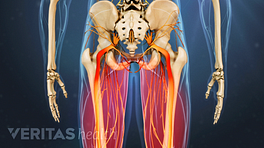While back pain is very common for adults, kids and teens are much more resilient and flexible and do not suffer the same types of back injuries to which adults are subject. In fact, medically significant back pain in children and teens is infrequently encountered, with even fewer cases in younger children.
Because children rarely suffer from back pain, any complaint by a child or teenager about acute back pain or chronic back pain is taken very seriously by Pediatricians, and usually will result in a detailed consultation that will include a review of the child’s medical history and a physical exam.
Suspicious episodes of back pain, or any concerning features of the pain, will result in radiological studies (such as an x-ray or MRI scan) and possibly a referral to a specialist for further examination and diagnostic tests.
Types of Back Pain in Kids and Teens
The most common causes of back pain in children and teenagers tend to be somewhat age-dependent.
Younger children are less likely to be putting their spine under the same severe stresses as older children and adults. Thus, for the most part younger children do not have medically significant back pain and their discomfort tends to be short-lived. Also, younger children tend to self-limit their activity, choosing not to repeat painful activities, which aids in their recovery if an episode of back pain does occur.
At a young age, if a child has back pain there is greater concern for the possibility of a serious condition, such as a spinal tumor, growth, or an infection of the spine. Therefore, if the back pain persists in a younger child despite a lack of re-injury, or if there are other symptoms suggestive of a more insidious process (infection or tumor), the child’s condition will most likely be considered atypical, and therefore, further work-up and medical examination will be indicated.
Older children tend to be more aggressive in their activities and sports, thereby increasing the risk of injury to the bones, nerves and soft tissues in the spine. Teenagers are also more likely to test the limits of their bodies, often being exhorted by commercial advertising and/or peer pressure to push the envelope.
At this point, compression fractures are more commonplace, and we begin to see occasional disc injuries. Older pediatric patients also can injure the joints between vertebral bones, causing painful stress injuries. Only very rarely do the nerve roots become compromised in older children.
Slightly older children can be convinced to minimize their activity to speed up healing times for back pain, but then they frequently return to the same injurious behavior that caused the initial damage. Here, older kids may also find themselves the victims of their own intermittent inactivity and suffer overuse injuries, similar to an adult who is a "weekend warrior".
For most injuries and episodes of back pain, the back pain treatment of choice is usually a short period of rest with an eye towards developing and maintaining physical conditioning.
Tumors and infection of the spine may occur in teens, but it is more common for back pain in teens to be caused by sports injuries or overuse syndromes.
Scoliosis among Kids and Teens
While scoliosis (curvature of the spine) is not an uncommon diagnosis among teenagers, it is very rare that adolescent scoliosis will cause back pain. Teens with scoliosis may develop back pain, just as other teenagers, but it has not been found that people with adolescent idiopathic scoliosis are any more likely to develop back pain than the rest of the population.






